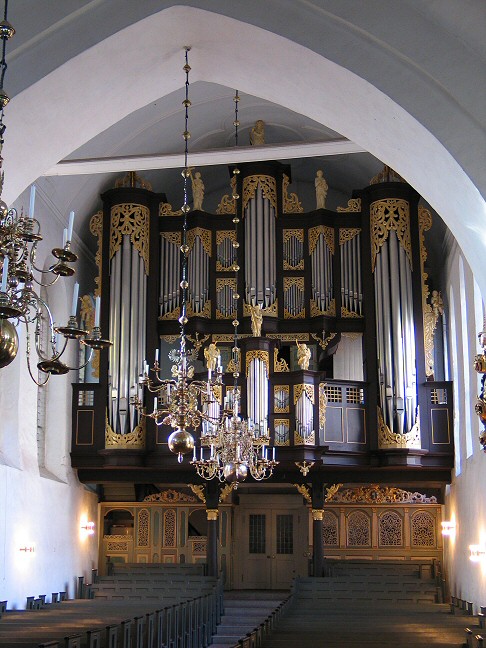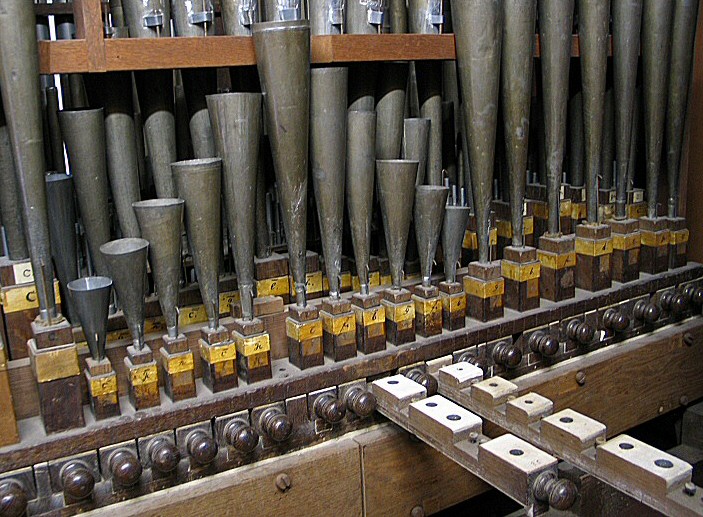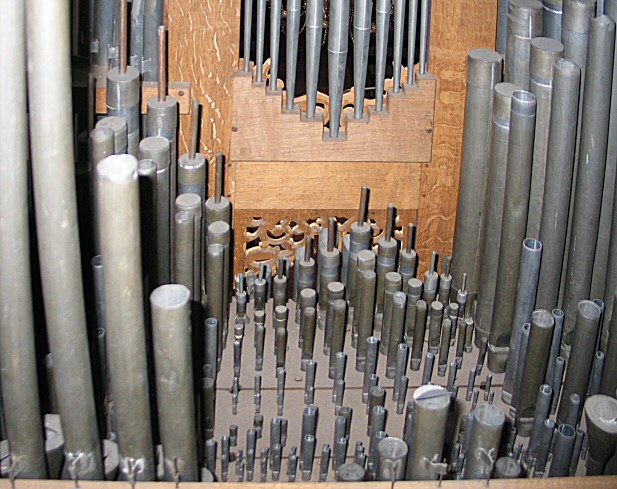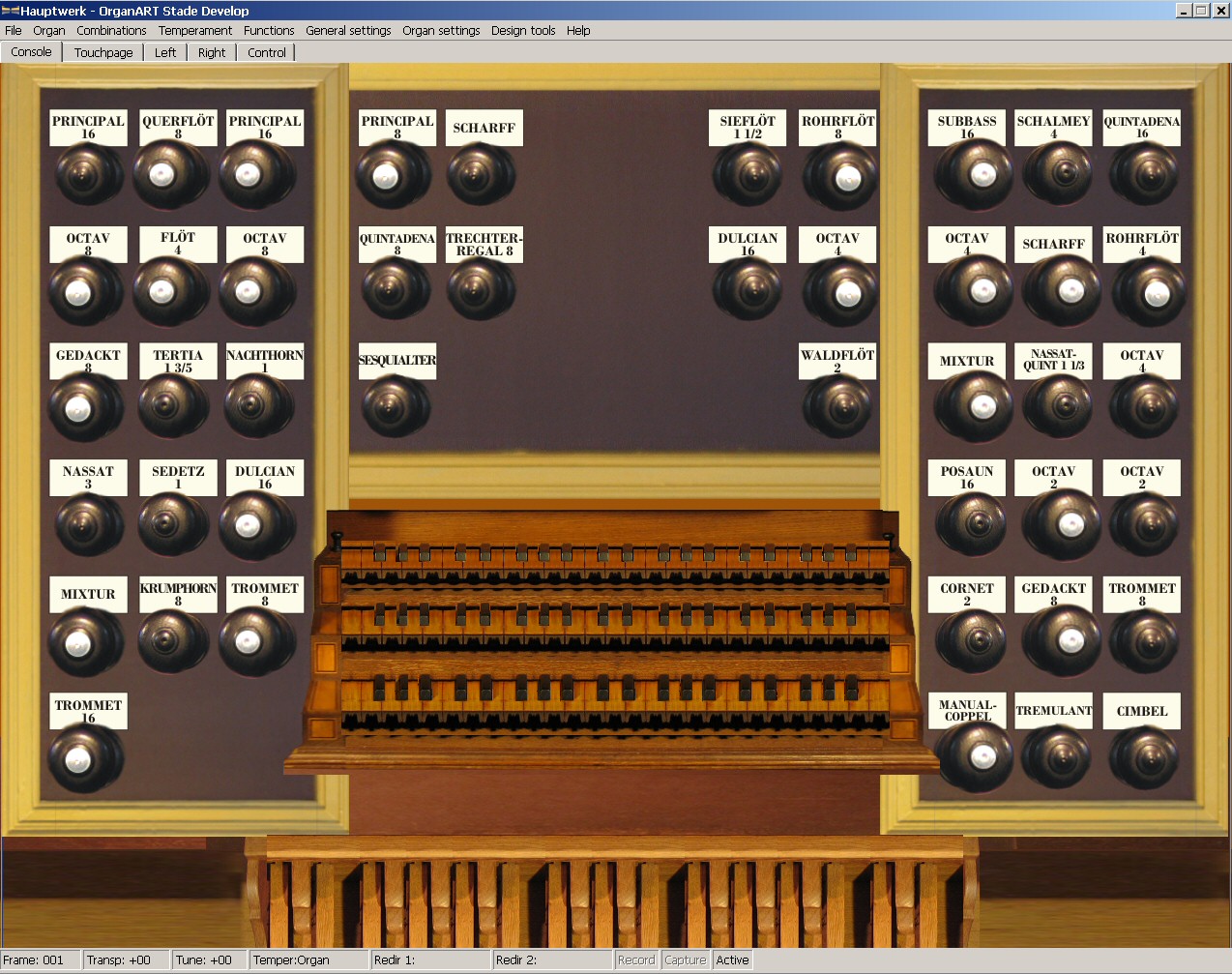1675/88 Hus/Arp Schnitger Organ
Ev.-Luth. Parish of St. Cosmae et Damiani
Short Introduction and History
The Hus-Schnitger organ in the St. Cosmae church in Stade, Lower Saxony, with its three manuals and 42 speaking stops on a 16 foot basis is one of the most important large North-German Baroque organs of this day. This organ gives an insight into the North-German organ culture of the 16th and 17th century and offers an authentic representation of organ compositions from this period. The instrument has an exceptionally large number of original pipes. Most reed ranks are original. The first organist in 1675 was Vincent Lübeck who worked here for 30 years.
After the end of the Thirty Year’s War in 1648 (the birth year of Arp Schnitger) which had culturally destroyed a large part of Germany, the building of a new large organ, that of the St. Cosmae in Stade, was a noteworthy project in a new era. At the time, Stade was the governmental capital of the Swedish Dukedom of Bremen.
After the great city fire of 1659, which also destroyed the Cosmae church with its original organ and the period of rebuilding, organbuilding master Berendt Hus of Glückstadt was delegated to build a new large organ for the St. Cosmae church.
In 1666 Arp Schnitger entered the employment of his uncle Hus at the age of 18. In 1670, at the age of 22, Arp Schnitger officially became his uncle’s journeyman. The uncommonly high salary shows how highly Arp Schnitger was esteemed and the importance of his role in the organ building trade.
The organ for Stade was built in several steps. A contract for the complete organ does not exist. In 1670 the bellows and the Hauptwerk (called Oberwerk) with double spring chests were completed and a start was made with the Rückpositiv. The organ front of the Hus-Schnitger organ shows the typical style of the “Hamburger Prospekt” , with Pedal, Hauptwerk, Brustwerk and Rückpositiv divisions.
The organ was finally completed in 1675. The instrument had 42 speaking stops and was tuned a whole tone higher than normal. Arp Schnitger was lauded with a gratification for his valuable labour. It is likely that Lübeck urged Schnitger to build four new stops for the organ in 1688: A Trommet 16, Cimbel for the Hauptwerk, a Krumphorn 8 and Schalmey 4 for the Brustwerk.
Various changes were made in the centuries that followed. A systematic restoration by Jürgen Ahrend of Loga including a reconstruction of the original organ loft took place in 1972-75. Additional repairs by Jürgen Ahrend were carried out 1993-94. A new paint job of the organ case based on a modern analysis of the historical substance followed in 2008.
The organ clearly carries the signature of both organ builders. While the Hauptwerk contains double spring chests, the Rückpositiv, Brustwerk and Pedal contain slider chests. The pipework has different characteristics than other existing Hus organs. The late Renaissance/early Baroque pipework and voicing of Hus produced a mild sound while that of Schnitger a much clearer, brighter and sharper sound, especially in the Mixtures, as is characteristic of the St. Cosmae organ. The reed stops blend well with the other stops as well. This shows that Arp Schnitger clearly had a large influence on the building of this organ.
The Hus-Schnitger organ is currently one of the most important large North German baroque organs and is the venue for many concerts, organists, organ study trips as well as workshops and was the foundation of Arp Schnitger’s exemplary career.
See Location in Googlemaps
Recording technique
The organ was recorded in Oct./Nov. 2008 with 48 kHz, 24 bit, multi-channel for Hauptwerk 3, using the multi-release technique introduced by OrganArt. The stops were recorded with multiple release levels for short, medium and long key attacks for optimal acoustical mapping. The Trechter Regal reed rank was additionally recorded with the original tremulant sound.
Thanks
I would like to thank the parish of Stade for granting permission to this project!
Special thanks are due to main organist KMD Martin Böcker for a lot of helpful information and discussions as well as Orgelbau Ahrend for preparing the instrument!
Last but not least special thanks to my wife, who assists all projects and is responsible for the photo documentation.
Virtual Console
Specification
NOTE: Click on the stop names for a small sound demo!
Oberwerk
|
Brustwerk (C,D,E,F,G,A–c3)*01. Gedackt 8 H/S Pedal (C,D,E–d1)*01. Principal 16 H/S-A |
Registration AidsManual shove coupler BW-OW Tremulant for the entire organ |
| H/S: Berendt Hus with the assistance of Arp Schnitger (1668–1675)
S: Arp Schnitger (1688) * Extended version: Manuals C–d3, Pedal C–f1 |
Pitch
1 whole tone above normal (a1 = 493 Hz)
Modified mean-tone temperament (3 pure tierces)
Blower System
6 historic bellows (actually 4 operable, also by calcants)
Wind pressure: 82 mm
Oberwerk: Double spring chest, otherwise slider chests
Requirements
Loaded Version |
Memory Requirements 3) |
Processor Speed |
| 16-bit, compressed1), single loop | 3300 MB | ≥ 2 GHz DualCore 2) |
|
16-bit, compressed1), all loops |
3900 MB |
≥ 2 GHz DualCore 2) |
|
20-bit, compressed, all loops |
6100 MB |
≥ 2 GHz DualCore 2) |
|
24-bit, compressed, all loops |
7100 MB |
≥ 2 GHz DualCore 2) |
1)Lossless compression (no loss of sound quality!)
2) Recommended:
Minimal configuration: Dual-Core, 4 GByte RAM
Optimal configuration: QuadCore, 8 GByte RAM
3) To load this organ into Hauptwerk you will need enough free memory in your computer, due to the amount of playable stops, not including the operating system or any other programs that may be running!
We recommend a professional audio card (e.g. RME-Series) and a studio headphone (e.g. AKG Reference Headphone K701, K712) for optimal sound and room impression.
Demos
The following demo pieces were recorded with the Hauptwerk Advanced Edition software and the virtual organ sample set, with no additional effects processing.
All demos are recorded with original organ temperament if not stated otherwise!
Live recorded demos by Anton Doornhein, Niederlande:
Vincent Lübeck (1654-1740)
Praeludium et Fuga in C | 6:34 min | Registrations
Praeludium et Fuga in F | 3:23 min | Registrations
J. P. Sweelinck (1562-1621)
Variations on "Soll es sein" | 7:37 min | Registrations
Heinrich Scheidemann (~1596-1663)
Magnificat VIII. Toni | Registrations
Versus 1 | 1:28 min
Versus 2 | 3:19 min
Versus 3 | 3:35 min
Versus 4 | 2:15 min
Canzon | 4:21 min| Registrations
Nicolaus Bruhns (1665-1697):
Praeludium et Fuga in e | 8:14 min | Registrations
D. Buxtehude (1637-1707)
Magnificat Primi Toni BuxWV 203 | 7:57 min | Registrations
Georg Böhm (1661-1733)
Choral "Vater unser im Himmelreich" | 5:38 min
Choralvariationen "Vater unser im Himmelreich", Versus 1 | 2:34 min
Choralvariationen "Vater unser im Himmelreich", Versus 2 | 4:23 min
J. S. Bach:
Praeludium (Toccata) et Fuga in C BWV 566 | 10:17 min | Registrations
Anonymous ancient music manuscripts
Susanne van Soldt manuscript (1599) | Registrations
Brande champanje | 2:27 min
Almande de symmerman | 0:55 min
Almande de La nonette | 0:52 min
De frans galliard | 1:03 min
Pavana Bassano | 2:07 min
Almande Brun Smeedelyn | 1:24 min
Brabanschen ronden dans ofte Brand | 4:38 min
Tobyas om sterven gheneghen | 1:06 min
Almande trycottee | 0:52 min
The Camphuysen manuscript (NL, 17th century) | Registrations
De Engelsche Fortuijn | 0:59 min
Daphne | 4:29 min
Live recorded demos by Fabio Mancini, Milano, Italy:
D. Buxtehude (1637-1707):
Choralvariationen "Wie schön leuchtet der Morgenstern" BuxWV 223 7:43 min
J. S. Bach:
Fuga in g BWV 542a (variant from Krebs manuscript) 5:53 min Kirnberger III temperament
Heinrich Scheidemann (~1596-1663):
Praeambulum III 1:08 min
Jan Pieterszoon Sweelinck (1562-1621):
Fantasia in a (Echo Fantasia) 3:57 min Mean-tone 4th comma
Choral "Nun komm der Heiden Heiland" 3:27 min Mean-tone 4th comma
Paul Hofhaimer (1459-1537):
Salve Regina 7:12 min
Numerous other live recordings can be found on the ConcertHall Website
((Advanced Search, Organ: OAM - Hus-Schnitger)
------------------------------------------------------------------------------------------------------------------------
Videos:
Jan Pieterszoon Sweelinck (1562-1621):
Variations on »Mein junges Leben hat ein End« from Prof. Christian Börsing on Vimeo.
Prof. Jürgen Kursawa plays Bruhns on the Hauptwerk Organ of Jörg Glebe, Deutschland
Klaus Müller, Dortmund, plays Lübeck on the Hauptwerk Organ of Jörg Glebe, Deutschland
© OrganArt Media, all rights reserved
No demo sounds may be used or transmitted in any form for public purposes without the prior written permission of the publisher!
Informations, Discography and Weblinks
Web-Links
Parish St. Cosmae
Arp Schnitger-Discography
Video about the organ and the spring chest system (in German)
CD-Productions (Selection):
Denkmäler barocker Orgelbaukunst
Martin Böcker, Hus-Schnitger-Orgel, Stade
(Praetorius, Scheidemann, Weßnitzer, Weckmann, Scheidt, Reincken, Buxtehude, Bach)
ambitus 97 800, 1994
Vincent Lübeck - Sämtliche Werke für Orgel und Cembalo
Martin Böcker, Hus-Schnitger-Orgel, Stade und Cembalo
ambitus 97 868, 1996/97
Bach in St. Cosmae
Martin Böcker, Hus-Schnitger-Orgel, Stade
classico, CR 201179, 2001
Aro Schnitger in Niedersachsen (CD1)
Claudia Heberlein-Johnson/USA, Hus-Schnitger-Orgel, Stade
(Lübeck, Buxtehude, Bruhns, Böhm etc.)
MDG, 1124-2, 2002
Vincent Lübeck - Das Orgelwerk
Joseph Kelemen, Hus-Schnitger-Orgel, Stade
OEHMS Classics OC 607, 2007
Dieterich Buxtehude - Die Choralfantasien, Vol. 2
Pier Damianao Peretti, Hus-Schnitger-Orgel, Stade
IFO Records 7224.3, 2007
Literature (in German):
Martin Böcker, Peter Golon
Die Orgelstadt Stade
Orgelakademie Stade e.V., 2004, S. 49-57
Martin Böcker
"seinem gesellen Arpen, zur Verehrunge"
Zeitschrift Organ 3/07, Schott-Verlag, S. 28-34
C.H. Edskes, Harald Vogel
Arp Schnitger und sein Werk
Verlag Hauschild, Bremen, 2009, S. 18-22, 171-172














